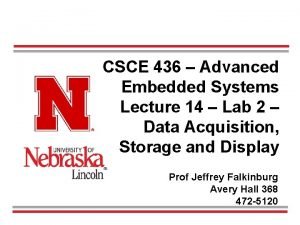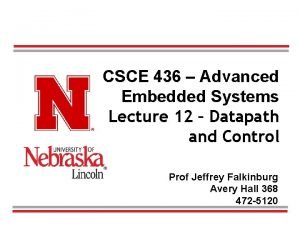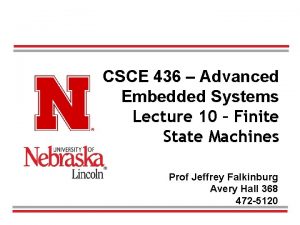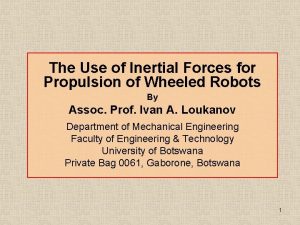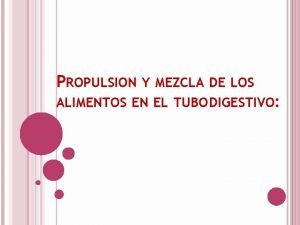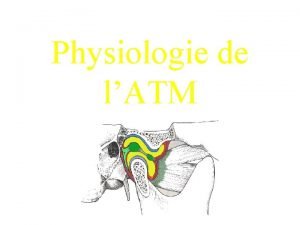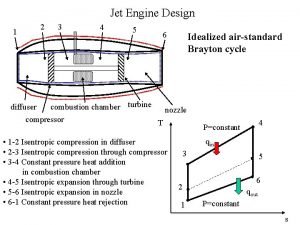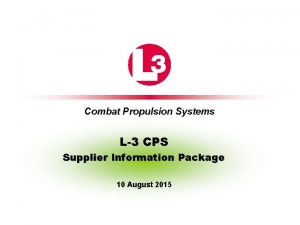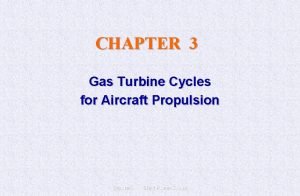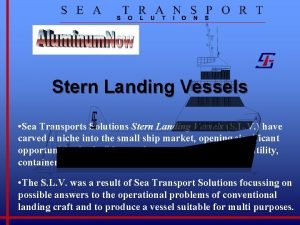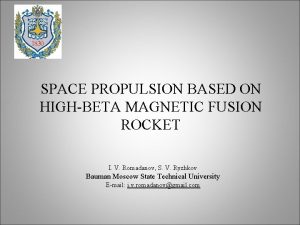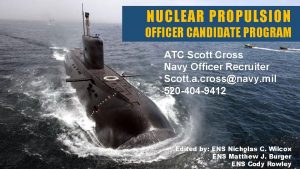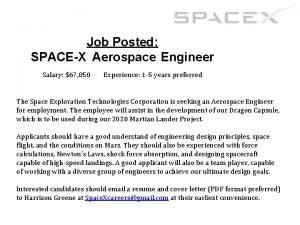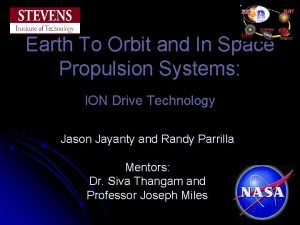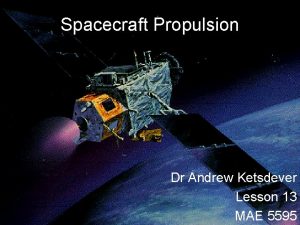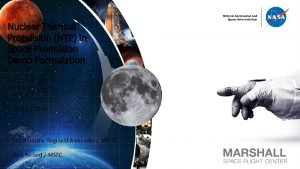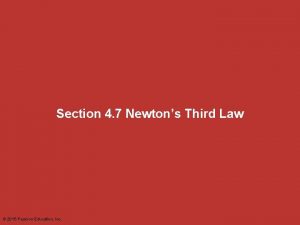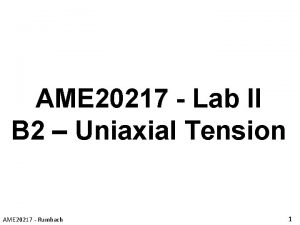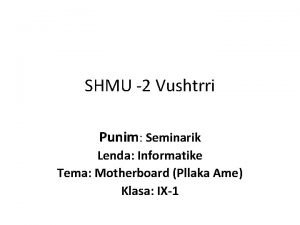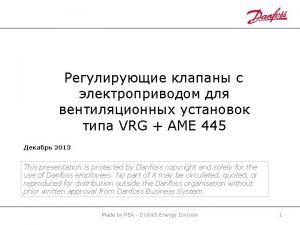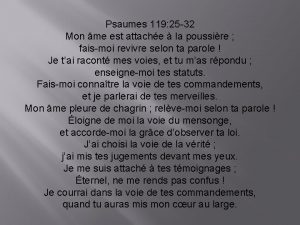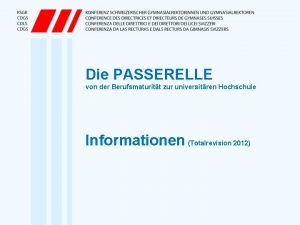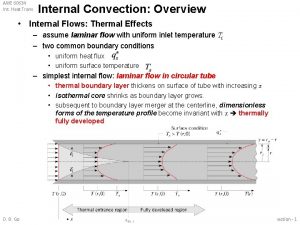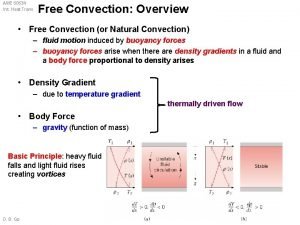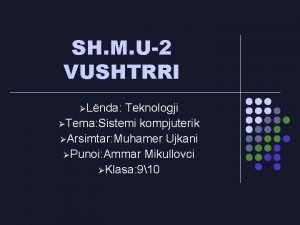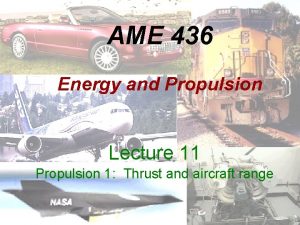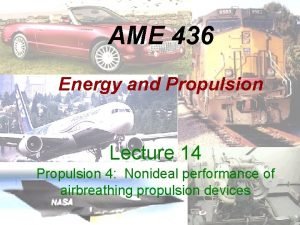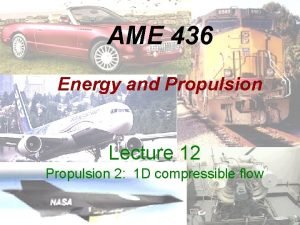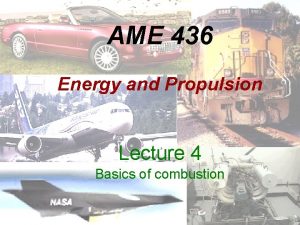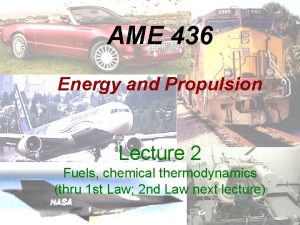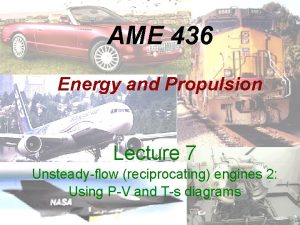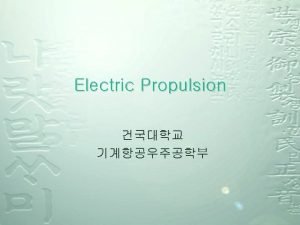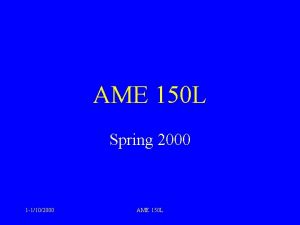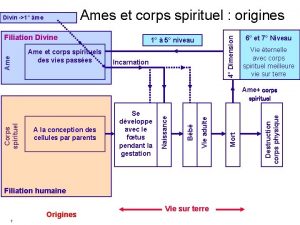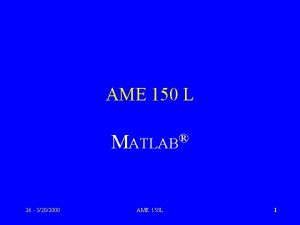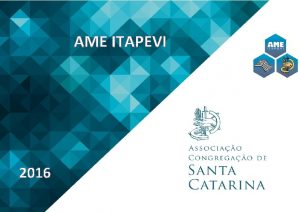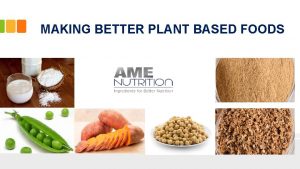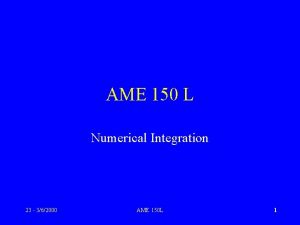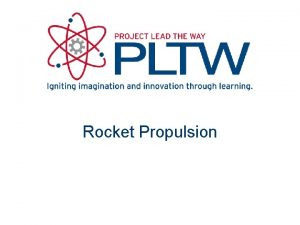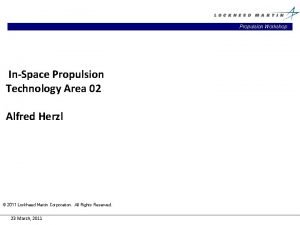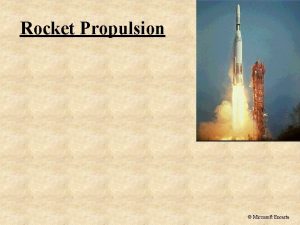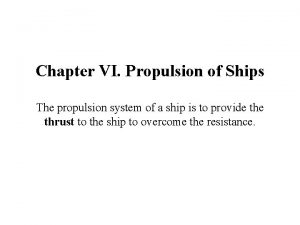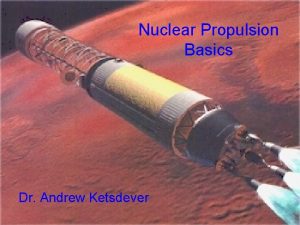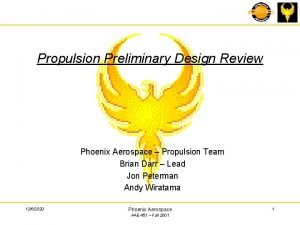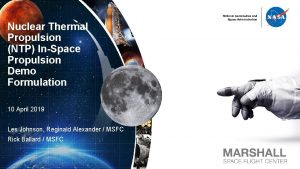AME 436 Energy and Propulsion Lecture 15 Propulsion













































- Slides: 45

AME 436 Energy and Propulsion Lecture 15 Propulsion 5: Hypersonic propulsion

Outline Ø Ø Why hypersonic propulsion? What's different about it? “Conventional” ramjet (heat addition at M << 1) Heat addition in compressible flows at M ≠ 0 (shortened version of what I didn’t cover in Lecture 12) Ø Air. Cycles 4 Hypersonics. xls spreadsheet Ø “Scramjet” cycles and performance AME 436 - Spring 2019 - Lecture 15 - Hypersonic Propulsion 2

Hypersonic propulsion - motivation Ø Why use air even if you're going to space? Ø Carry only fuel, not fuel + O 2, while in atmosphere » 8 x mass savings (H 2 -O 2), 4 x (hydrocarbons) » Actually more than this when ln( ) term in Breguet range equation is considered Ø Use aerodynamic lifting body rather than ballistic trajectory » Ballistic: need Thrust/weight > 1 » Lifting body, steady flight: Lift (L) = weight (mg); Thrust (T) = Drag (D), Thrust/weight = L/D > 1 for any decent airfoil, even at hypersonic conditions L T D mg AME 436 - Spring 2019 - Lecture 15 - Hypersonic Propulsion 3

What's different about hypersonic propulsion? Ø Stagnation temperature Tt - measure of total energy (thermal + kinetic) of flow - is really large even before heat addition - materials problems Ø Stagnation pressure - measure of usefulness of flow (ability to expand flow) is really large even before heat addition - structural problems Ø Large Pt means no mechanical compressor needed at large M Ø Why are Tt and Pt so important? Recall (Lecture 12) isentropic expansion to Pe = Pa (optimal exit P yielding maximum thrust) yields Ø … but it's difficult to add heat at high M without major loss of stagnation pressure AME 436 - Spring 2019 - Lecture 15 - Hypersonic Propulsion 4

What's different about hypersonic propulsion? Ø High temperatures: not constant, also molecular weight not constant dissociation - use GASEQ (http: //www. gaseq. co. uk) to compute stagnation conditions Ø Example calculation: standard atmosphere at 100, 000 ft Ø T 1 = 227 K, P 1 = 0. 0108 atm, c 1 = 302. 7 m/s, h 1 = 70. 79 k. J/kg (atmospheric data from http: //www. digitaldutch. com/atmoscalc/) Ø Pick P 2 > P 1, compress isentropically, note new T 2 and h 2 Ø 1 st Law: h 1 + u 12/2 = h 2 + u 22/2; since u 2 = 0, h 2 = h 1 + (M 1 c 1)2/2 or M 1 = [2(h 2 -h 1)/c 12]1/2 Ø Simple relations ok up to M ≈ 7 Ø Dissociation not as bad as might otherwise be expected at ultra high T, since P increases faster than T Ø Limitations of these estimates Ø Ionization not considered Ø Stagnation temperature relation valid even if shocks, friction, etc. (only depends on 1 st law) but stagnation pressure assumes isentropic flow Ø Calculation assumed adiabatic deceleration - radiative loss (from surfaces and ions in gas) may be important AME 436 - Spring 2019 - Lecture 15 - Hypersonic Propulsion 5

What's different about hypersonic propulsion? WOW! HOT 5000 K 3000 K N+O+e- N 2+O WARM COLD 1000 K N 2+O 2 200 K N 2+O 2 AME 436 - Spring 2019 - Lecture 15 - Hypersonic Propulsion 6

“Conventional” ramjet Ø Ø Ø Incoming air decelerated isentropically to M = 0 - high T, P No compressor needed, so only parameters are M 1 Heat addition at M = 0 - no loss of Pt - to max. allowable T 4 = T 1 Expand to P 9 = P 1 Doesn't work well at low M - Pt/P 1 & Tt/T 1 low - Carnot efficiency low As M increases, Pt/P 1 and Tt/T 1 increases, cycle efficiency increases, but if M too high, limited ability to add heat (Tt close to Tmax) - high efficiency but less thrust � � � AME 436 - Spring 2019 - Lecture 15 - Hypersonic Propulsion 7

“Conventional” ramjet - effect of M 1 Ø “Banana” shaped cycles for low M 1, tall skinny cycles for high M 1, “fat” cycles for intermediate M 1 Basic ramjet = 7 AME 436 - Spring 2019 - Lecture 15 - Hypersonic Propulsion 8

“Conventional” ramjet example Ø Example: M 1 = 5, = 12, = 1. 4 Ø Initial state (1): M 1 = 5 Ø State 2: decelerate to M 2 = 0 Ø State 4: add at heat const. P; M 4 = 0, P 4 = P 2 = 529. 1 P 1, T 4 = 12 T 1 Ø State 9: expand to P 9 = P 1 AME 436 - Spring 2019 - Lecture 15 - Hypersonic Propulsion 9

“Conventional” ramjet example Ø Specific thrust (ST) (assume FAR << 1) Ø TSFC and overall efficiency AME 436 - Spring 2019 - Lecture 15 - Hypersonic Propulsion 10

“Conventional” ramjet - effect of M 1 Basic ramjet = 7 AME 436 - Spring 2019 - Lecture 15 - Hypersonic Propulsion 11

Scramjet (Supersonic Combustion RAMjet) Ø What if Tt > Tmax allowed by materials or Pt > Pmax allowed by structure? Can't decelerate to M = 0! Ø Need to mix fuel & burn supersonically, never allowing air to decelerate to M=0 Ø Many laboratory studies, very few successful test flights (e. g. X-43 below) AME 436 - Spring 2019 - Lecture 15 - Hypersonic Propulsion 12

Scramjet (Supersonic Combustion RAMjet) Ø Australian project (Hy. Shot): Ø http: //hypersonics. mechmining. uq. edu. au/hyshot-about Ø US project (X-43) Ø https: //www. nasa. gov/centers/dryden/history/pastprojects/Hyper. X/index. html Ø Steady flight (thrust ≈ drag) achieved at M 1 ≈ 9. 65 at 110, 000 ft altitude (u 1 ≈ 2934 m/s = 6562 mi/hr) Ø 3. 8 lbs. H 2 burned during 10 - 12 second test Ø Rich H 2 -air mixtures ( ≈ 1. 2 - 1. 3), ignition with silane (Si. H 4, ignites spontaneously in air) Ø …but no information about the conditions at the combustor inlet, or the conditions during combustion (constant P, T, area, …? ) Ø Real-gas stagnation temperatures 3300 K (my model, slide 36: 3500 K), surface temperatures up to 2250 K (!) ØUSAF X-51 Ø http: //www. af. mil/About-Us/Fact-Sheets/Display/Article/104467/x-51 a-waverider/ Ø Acceleration to steady flight achieved at M 1 ≈ 5 at 70, 000 ft for 140 seconds using hydrocarbon fuel AME 436 - Spring 2019 - Lecture 15 - Hypersonic Propulsion 13

1 D steady flow of ideal gases (Lecture 11) Ø Assumptions Ø Ø Ideal gas, steady, quasi-1 D Constant CP, Cv, CP/Cv Unless otherwise noted: adiabatic, reversible, constant area Note since 2 nd Law states d. S ≥ Q/T (= for reversible, > for irreversible), reversible + adiabatic isentropic (d. S = 0) Ø Governing equations Ø Equations of state Ø Isentropic (S 2 = S 1) (where applicable): Ø Mass conservation: Ø Momentum conservation, constant area duct (see lecture 11): » Cf = friction coefficient; C = circumference of duct » No friction: Ø Energy conservation: q = heat input per unit mass = f. QR if due to combustion w = work output per unit mass AME 436 - Spring 2019 - Lecture 15 - Hypersonic Propulsion 14

1 D steady flow of ideal gases (Lecture 11) Ø Types of analyses: everything constant except… Ø Area (isentropic nozzle flow) – already covered Ø Entropy (shock) - skip Ø Momentum (Fanno flow) (constant area with friction) - skip Ø Diabatic (q ≠ 0) - several possible assumptions - covered here » Constant area A (Rayleigh flow) (useful if limited by space) » Constant T (useful if limited by materials) (sounds weird, heat addition at constant T…) » Constant P (useful if limited by structure) Ø Products of analyses Ø Stagnation temperature Ø Stagnation pressure Ø Mach number = u/c = u/( RT)1/2 (recall c = sound speed at local conditions in the flow (NOT at ambient condition!)) Ø From this, can get exit velocity u 9, exit pressure P 9 and thus thrust AME 436 - Spring 2019 - Lecture 15 - Hypersonic Propulsion 15

Heat addition at const. Area (Rayleigh flow) Ø Mass, momentum, energy, equation of state all apply Ø Reference state ( )*: use M = 1 (not a throat in this case!) Ø Energy equation not useful except to calculate heat input (q = Cp(T 2 t - T 1 t)) AME 436 - Spring 2019 - Lecture 15 - Hypersonic Propulsion 16

Heat addition at constant area Pt/Pt* Tt/Tt* P/P* T/T* AME 436 - Spring 2019 - Lecture 15 - Hypersonic Propulsion 17

Heat addition at const. area Ø Implications Ø Stagnation temperature always increases towards M = 1 Ø Stagnation pressure always decreases towards M = 1 (stagnation temperature increasing, more heat addition) Ø Can't cross M = 1 with constant area heat addition! Ø M = 1 corresponds to the maximum possible heat addition Ø …but there's no particular reason we have to keep area (A) constant when we add heat! Ø What if neither the initial state (1) nor final state (2) is the choked (*) state? Use P 2/P 1 = (P 2/P*)/(P 1/P*) etc. AME 436 - Spring 2019 - Lecture 15 - Hypersonic Propulsion 18

Heat addition at constant pressure Ø Relevant for hypersonic propulsion if maximum allowable pressure (i. e. structural limitation) is the reason we can't decelerate the ambient air to M = 0) Ø Momentum equation: Ad. P + du = 0 u = constant Ø Reference state ( )*: use M = 1 again but nothing special happens there Ø Again energy equation not useful except to calculate q Ø Implications Ø Stagnation temperature increases as M decreases, i. e. heat addition corresponds to decreasing M Ø Stagnation pressure decreases as M decreases, i. e. heat addition decreases stagnation P Ø Area increases as M decreases, i. e. as heat is added AME 436 - Spring 2019 - Lecture 15 - Hypersonic Propulsion 19

Heat addition at constant P Pt/Pt* P/P* Tt/Tt* T/T*, A/A* AME 436 - Spring 2019 - Lecture 15 - Hypersonic Propulsion 20

Heat addition at constant pressure Ø What if neither the initial state (1) nor final state (2) is the reference (*) state? Again use P 2/P 1 = (P 2/P*)/(P 1/P*) etc. AME 436 - Spring 2019 - Lecture 15 - Hypersonic Propulsion 21

Heat addition at constant temperature Ø Probably most appropriate case for hypersonic propulsion since temperature (materials) limits is usually the reason we can't decelerate the ambient air to M = 0 Ø T = constant c (sound speed) = constant Ø Momentum: Ad. P + du = 0 d. P/P + Md. M = 0 Ø Reference state ( )*: use M = 1 again Ø Implications Ø Stagnation temperature increases as M increases Ø Stagnation pressure decreases as M increases, i. e. heat addition decreases stagnation P Ø Minimum area (i. e. throat) at M = -1/2 Ø Large area ratios needed due to exp[ ] term AME 436 - Spring 2019 - Lecture 15 - Hypersonic Propulsion 22

Heat addition at constant T Tt/Tt* A/A* T/T* Pt/Pt* P/P* AME 436 - Spring 2019 - Lecture 15 - Hypersonic Propulsion 23

Heat addition at constant temperature Ø What if neither the initial state (1) nor final state (2) is the reference (*) state? Again use P 2/P 1 = (P 2/P*)/(P 1/P*) etc. AME 436 - Spring 2019 - Lecture 15 - Hypersonic Propulsion 24

T-s diagram for diabatic flows Const P Const T Rayleigh (Const A) AME 436 - Spring 2019 - Lecture 15 - Hypersonic Propulsion 25

T-s diagram for diabatic flows Rayleigh (Const A) Const P Const T AME 436 - Spring 2019 - Lecture 15 - Hypersonic Propulsion 26

Area ratios for diabatic flows Const T Const P Const A AME 436 - Spring 2019 - Lecture 15 - Hypersonic Propulsion 27

What is the best way to add heat? Ø If maximum T or P is limitation, obviously use that case Ø What case gives least Pt loss for given increase in Tt? Ø Minimize d(Pt)/d(Tt) subject to mass, momentum, energy conservation, eqn. of state Ø Result (lots of algebra - many trees died to bring you this result) Ø Adding heat (increasing Tt) always decreases Pt Ø Least decrease in Pt occurs at lowest possible M – doesn’t matter if it's at constant A, P, T, etc. AME 436 - Spring 2019 - Lecture 15 - Hypersonic Propulsion 28

Summary of heat addition processes Const. A Const. P Const. T M Goes to M=1 Decreases Increases Area Constant Increases Min. at M = -1/2 P Decr. M < 1 Incr. M > 1 Constant Decreases Pt Decreases T Incr. except for a small region at M<1 Increases Constant Tt Increases AME 436 - Spring 2019 - Lecture 15 - Hypersonic Propulsion 29

Air. Cycles 4 Hypersonics. xls Ø Diffuser – same as Air. Cycles 4 Propulsion. xls except that M 2 is specified rather than M 2 = 0 Ø Compressor – NONE Ø Combustor Ø Heat addition may be at constant area (Rayleigh flow), P or T Ø Mach number after diffuser is a specified quantity (not necessarily zero) - Mach number after diffuser sets compression ratio since there is no mechanical compressor Ø Rayleigh curves starting at states 1 and 2 included to show constant area / no friction on T-s Ø Turbine – NONE Ø Nozzle – same as Air. Cycles 4 Propulsion. xls AME 436 - Spring 2019 - Lecture 15 - Hypersonic Propulsion 30

Air. Cycles 4 Hypersonics. xls Ø Combustion parameter = T 4 t/T 1 (specifies stagnation temperature, not static temperature, after combustion) Ø Caution on choosing Ø If T 1 < r. T 1 ( r = 1 + ( -1)/2 M 12) (maximum allowable temperature after heat addition > temperature after deceleration) then no heat can be added (actually, spreadsheet will try to refrigerate the gas…) Ø For constant-area heat addition, if T 1 is too large, you can’t add that much heat (beyond thermal choking point) & spreadsheet “chokes” Ø For constant-T heat addition, if T 1 is too large, pressure after heat addition < ambient pressure - overexpanded jet - still works but performance suffers Ø For constant-P heat addition, no limits! But temperatures go sky-high Ø All cases: f (fuel mass fraction) needed to obtain specified is calculated - make sure this doesn’t exceed fstoichiometric! AME 436 - Spring 2019 - Lecture 15 - Hypersonic Propulsion 31

Hypersonic propulsion (const. T) - T-s diagrams Ø With Const. T combustion, maximum temperature within sane limits, but as more heat is added, P decreases, eventually P 4 < P 9 Ø Also, latter part of cycle has low Carnot-strip efficiency since constant T and P lines will converge Const. T combustion, M 1 = 10; M 2 = 2. 61 (T 2 = 2000 K) Stoich. H 2 -air (f = 0. 0283, QR = 1. 2 x 108 J/kg = 35. 6) AME 436 - Spring 2019 - Lecture 15 - Hypersonic Propulsion 32

Hypersonic propulsion (const. T) - effect of M 1 Ø Minimum M 1 = 6. 28 - below that T 2 < 2000 even if M 2 = 0 Ø No maximum M 2 Ø overall improves slightly at high M 1 due to higher thermal (lower T 9) Const. T combustion, M 1 = varies; M 2 adjusted so that T 2 = 2000 K; H 2 -air (QR = 1. 2 x 108 J/kg), adjusted so that f = fstoichiometric AME 436 - Spring 2019 - Lecture 15 - Hypersonic Propulsion 33

Hypersonic propulsion (const. T) - effect of M 1 = 10, T 2 = 2000 K specified M 2 = 2. 61 At = 21. 1 no heat can be added At = 35. 6, f = 0. 0283 (stoichiometric H 2 -air) At = 40. 3 (assuming one had a fuel with higher heating value than H 2), P 4 = P 9 Ø f & Specific Thrust increase as more fuel is added ( increasing), overall & ISP decrease due to low thermal at high heat addition (see T-s diagram) Ø Ø Const. T combustion, M 1 = 10; M 2 = 2. 61 (T 2 = 2000 K) H 2 -air (QR = 1. 2 x 108 J/kg), (thus f) varies AME 436 - Spring 2019 - Lecture 15 - Hypersonic Propulsion 34

Hypersonic propulsion (const. T) - effect of M 2 Ø Maximum M 2 = 3. 01 - above that P 4 < P 9 after combustion (you could go have higher M 2 but why would you want to - heat addition past P 4 = P 9 would reduce thrust!) Ø No minimum M 2, but lower M 2 means higher T 2 - maybe beyond materials limits (after all, high T 1 t is the whole reason we’re looking at alternative ways to burn at hypersonic Mach numbers) Ø overall decreases at higher M 2 due to lower thermal (lower T 2) Const. T combustion, M 1 = 10; M 2 varies; H 2 -air (QR = 1. 2 x 108 J/kg), adjusted so that f = fstoichiometric AME 436 - Spring 2019 - Lecture 15 - Hypersonic Propulsion 35

Hypersonic propulsion (const. T) - effect of d Ø Obviously as d decreases, all performance parameters decrease Ø If d too low, pressure after stoichiometric heat addition < P 1, so need to decrease heat addition (thus ) Ø Diffuser can be pretty bad ( d ≈ 0. 25) before no thrust Const. T combustion, M 1 = 10; M 2 = 2. 611; H 2 -air (QR = 1. 2 x 108 J/kg), adjusted so that f = fstoichiometric or P 5 = P 1, whichever is smaller AME 436 - Spring 2019 - Lecture 15 - Hypersonic Propulsion 36

Hypersonic propulsion (const. T) - effect of n Ø Obviously as n decreases, all performance parameters decrease Ø Nozzle can be pretty bad ( n ≈ 0. 32) before no thrust, but not as bad as diffuser Const. T combustion, M 1 = 10; M 2 = 2. 611; H 2 -air (QR = 1. 2 x 108 J/kg), adjusted so that f = fstoichiometric AME 436 - Spring 2019 - Lecture 15 - Hypersonic Propulsion 37

Hypersonic propulsion (const. P) - T-s diagrams Ø With Const. P combustion, no limitations on heat input, but maximum temperature becomes insane (actually dissociation & heat losses would decrease this T substantially) Ø Carnot-strip (thermal) efficiency independent of heat input; same as conventional Brayton cycle (s-P-s-P cycle) Const. P combustion, M 1 = 10; M 2 = 2. 61 (T 2 = 2000 K) Stoich. H 2 -air (f = 0. 0283, QR = 1. 2 x 108 J/kg = 35. 6) AME 436 - Spring 2019 - Lecture 15 - Hypersonic Propulsion 38

Hypersonic propulsion (const. P) - performance Ø Ø Ø M 1 = 10, T 2 = 2000 K specified M 2 = 2. 61 Still, at = 21. 1 no heat can be added At = 35. 6, f = 0. 0283 (stoichiometric H 2 -air) No upper limit on (assuming one has a fuel with high enough QR) f & Specific Thrust increase as more fuel is added ( increasing), overall & ISP decrease only slightly at high heat addition due to lower propulsive Const. P combustion, M 1 = 10; M 2 = 2. 61 (T 2 = 2000 K) H 2 -air (QR = 1. 2 x 108 J/kg), (thus f) varies AME 436 - Spring 2019 - Lecture 15 - Hypersonic Propulsion 39

Hypersonic propulsion (const. A) - T-s diagrams Ø With Const. A combustion, heat input limited by thermal choking, maximum temperature even more insane than constant P Ø … but Carnot-strip efficiency is awesome! Const. A combustion, M 1 = 10; M 2 = 2. 61 (T 2 = 2000 K) H 2 -air (f = 0. 0171, QR = 1. 2 x 108 J/kg = 30. 1; (can’t add stoichiometric amount of fuel at constant area for this M 1 and M 2)) AME 436 - Spring 2019 - Lecture 15 - Hypersonic Propulsion 40

Hypersonic propulsion (const. A) - performance Ø Ø M 1 = 10, T 2 = 2000 K specified M 2 = 2. 61 Still, at = 21. 1 no heat can be added At = 30. 5, thermal choking at f = 0. 0193 < 0. 0283 f & Specific Thrust increase as more fuel is added ( increasing), overall & ISP decrease slightly at high heat addition due to lower propulsive Const. A combustion, M 1 = 10; M 2 = 2. 61 (T 2 = 2000 K) H 2 -air (QR = 1. 2 x 108 J/kg), (thus f) varies AME 436 - Spring 2019 - Lecture 15 - Hypersonic Propulsion 41

Example Consider a very simple propulsion system in a standard atmosphere at 100, 000 feet (227 K and 0. 0107 atm, with = 1. 4) in which (1) Incoming air is decelerated isentropically from M 1 = 15 until T = 3000 K (2) Heat is added at constant T until ambient pressure is reached (not a good way to operate, but this represents a sort of maximum heat addition) (a) To what Mach number could the air be decelerated if the maximum allowable gas temperature is 3000 K? What is the corresponding pressure? AME 436 - Spring 2019 - Lecture 15 - Hypersonic Propulsion 42

Example - continued (b) What is the exit Mach (M 9) number? (Note that heat is added until P 3 = P 1, so there is no separate nozzle (3 9) in this case. ) What is the area ratio? (c) What is the specific thrust? ST = Thrust/ M 1 , c 1 = (u 9 – u 1)/ c 1 = (M 9 c 9 – M 1 c 1)/c 1 = Me(Te/T 1)1/2 – ST = M 9(T 9/T 1)1/2 – M 1 = 5. 031(3000 K/227 K)1/2 – 15 = 3. 289 AME 436 - Spring 2019 - Lecture 15 - Hypersonic Propulsion 43

Example - continued (d) What is the thrust specific fuel consumption and overall efficiency? TSFC = (Heat input)/Thrust*c 1 = [ (CP(T 3 t – T 2 t)c 1]/[Thrust*c 12] = [( c 1)/Thrust] [( /( ‑ 1))R(T 3 t–T 2 t)/( RT 1)] = [1/(ST)] [1/( ‑ 1)] [(T 3 t –T 2 t)/T 1] (e) Can stoichiometric hydrogen-air mixtures generate enough heat to accomplish this? Determine if the heat release per unit mass = fstoich. QR is equal to or greater than the heat input needed = CP(T 3 t – T 2 t). AME 436 - Spring 2019 - Lecture 15 - Hypersonic Propulsion 44

Summary Ø Propulsion at high Mach numbers is very different from conventional propulsion because Ø The optimal thermodynamic cycle (decelerate to M = 0) yields impracticably high T & P Ø Deceleration from high M to low M without major Pt losses is difficult Ø Propulsive efficiency ≈ 2 u 1/(u 1+u 9) is always high Ø 3 ways of adding heat discussed Ø Constant T » Probably most practical case » Low efficiency with large heat addition » Large area ratios Ø Constant P - best performance but very high T Ø Constant A - thermal choking limits heat input AME 436 - Spring 2019 - Lecture 15 - Hypersonic Propulsion 45
 Csce 436
Csce 436 Csce 436
Csce 436 Csce 436
Csce 436 Physical science 436
Physical science 436 01:640:244 lecture notes - lecture 15: plat, idah, farad
01:640:244 lecture notes - lecture 15: plat, idah, farad Energy energy transfer and general energy analysis
Energy energy transfer and general energy analysis Energy energy transfer and general energy analysis
Energy energy transfer and general energy analysis Inertial propulsion
Inertial propulsion Propulsión en el sistema digestivo
Propulsión en el sistema digestivo Diagramme de posselt
Diagramme de posselt Propulsion efficiency
Propulsion efficiency L3 cps
L3 cps Turbojet vs turbofan
Turbojet vs turbofan Sea transport solutions stern landing vessel
Sea transport solutions stern landing vessel Magnetic space propulsion
Magnetic space propulsion Nuclear propulsion officer salary
Nuclear propulsion officer salary Spacex data scientist salary
Spacex data scientist salary Siva de scalzo
Siva de scalzo Nuclear propulsion
Nuclear propulsion Propellantless propulsion
Propellantless propulsion Nuclear thermal propulsion
Nuclear thermal propulsion 10 year old sarah stands on a skateboard
10 year old sarah stands on a skateboard Utilities and energy lectures
Utilities and energy lectures Ame church emblem
Ame church emblem Que tes vives eaux inondent mon âme
Que tes vives eaux inondent mon âme Que rien ne te trouble, ô mon âme partition
Que rien ne te trouble, ô mon âme partition Petrit ame
Petrit ame Ame 20217
Ame 20217 San agustin tarde te ame
San agustin tarde te ame Pllaka ame
Pllaka ame Shmu 2 vushtrri
Shmu 2 vushtrri Ame
Ame Komponentet e motherboard
Komponentet e motherboard Ame 445
Ame 445 Mon ame est attache a toi
Mon ame est attache a toi Usc ame
Usc ame Je me tiens à la porte et je frappe partition
Je me tiens à la porte et je frappe partition Ame bibapi
Ame bibapi Passerelle prüfung
Passerelle prüfung Cuando me ame de verdad
Cuando me ame de verdad Trans ame
Trans ame Rayleigh number
Rayleigh number A mia mi piace a nutella
A mia mi piace a nutella Pllaka ame
Pllaka ame Amé la justicia y odié la iniquidad
Amé la justicia y odié la iniquidad Poema quando me amei de verdade charles chaplin
Poema quando me amei de verdade charles chaplin
